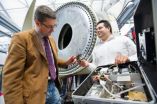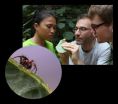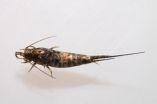(Press-News.org) Researchers at the Universities of Southampton, Plymouth and Exeter used the test to assess the levels of epigenetic switches in the PGC1a gene – a gene that regulates fat storage in the body.
Epigenetic switches take place through a chemical change called DNA methylation, which controls how genes work and is set during early life.
The Southampton team found that the test, when carried out on children at five years old, differentiates between children with a high body fat and those with a low body fat when they were older. Results showed that a rise in DNA methylation levels of 10 per cent at five years was associated with up to 12 per cent more body fat at 14 years. Results were independent of the child's gender, their amount of physical activity and their timing of puberty.
Dr Graham Burdge, of the University of Southampton who led the study with colleague Dr Karen Lillycrop, comments: "It can be difficult to predict when children are very young, which children will put on weight or become obese. It is important to know which children are at risk because help, such as suggestions about their diet, can be offered early and before they start to gain weight.
"The results of our study provide further evidence that being overweight or obese in childhood is not just due to lifestyle, but may also involve important basic processes that control our genes. We hope that this knowledge will help us to develop and test new ways to prevent children developing obesity which can be introduced before a child starts to gain excess weight. However, our findings now need to be tested in larger groups of children."
The study, which also involved Professor Terence Wilkin at the University of Exeter and Dr Joanne Hosking at Plymouth University, is published in the journal Diabetes. The researchers used DNA samples from 40 children who took part in the EarlyBird project, which studied 300 children in Plymouth from the age of five until they were 14 years old.
Led by Professor Wilkin, the study assessed the children in Plymouth each year for factors related to type 2 diabetes, such as the amount of exercise they undertook and the amount of fat in their body. A blood sample was collected and stored. The Southampton team extracted DNA from these blood samples to test for epigenetic switches.
Joanne Hosking, research fellow at Plymouth University, says: "This a unique longitudinal data set and we hope to gain even further insight by looking at what happens in these children beyond age 14 years and into adulthood."
Professor Wilkin says: "The EarlyBird study has already provided important information about the causes of obesity in children. Now samples stored during the study have provided clues about the role of fundamental processes that affect how genes work, over which a child has no control. This has shown that these mechanisms can affect their health during childhood and as adults."
INFORMATION: END
Simple blood test may predict if a child will become obese
2014-03-27
ELSE PRESS RELEASES FROM THIS DATE:
Predicting oil changes in industrial applications without interrupting operations
2014-03-27
This news release is available in German.
Predictive maintenance of hard-to-access plants, no unnecessary oil changes, no unnecessary laboratory costs and less environmental impact. These are just some of the benefits offered by a new system that can monitor the condition of lubricating oils, hydraulic oils and other fluids in industrial installations without interrupting ongoing operations. The method was developed by engineers from Saarbrücken in collaboration with project partners. The compact sensor system is available as a portable unit or can be built into ...
Democratizing data visualization
2014-03-27
In 2007, members of the Haystack Group in MIT's Computer Science and Artificial Intelligence Laboratory released a set of Web development tools called "Exhibit." Exhibit lets novices quickly put together interactive data visualizations, such as maps with sortable data embedded in them; sortable tables that automatically pull in updated data from other sites; and sortable displays of linked thumbnail images.
In April, at the Association for Computing Machinery's Conference on Human Factors in Computing Systems, Haystack members will present an in-depth study of the ways ...
Students on field course bag new spider species
2014-03-27
As a spin-off (pun intended) of their Tropical Biodiversity course in Malaysian Borneo, a team of biology students discover a new spider species, build a makeshift taxonomy lab, write a joint publication and send it off to a major taxonomic journal.
Discovering a new spider species was not what she had anticipated when she signed up for her field course in Tropical Biodiversity, says Elisa Panjang, a Malaysian master's student from Universiti Malaysia Sabah. She is one of twenty students following the course, organised by Naturalis Biodiversity Center in The Netherlands, ...
The first insects were not yet able to smell well
2014-03-27
This news release is available in German. An insect's sense of smell is vital to its survival. Only if it can trace even tiny amounts of odor molecules is it is able to find food sources, communicate with conspecifics, or avoid enemies. According to scientists at the Max Planck Institute for Chemical Ecology in Jena, Germany, many proteins involved in the highly sensitive odor perception of insects emerged rather late in the evolutionary process. The very complex olfactory system of modern insects is therefore not an adaptation to a terrestrial environment when ancient ...
One gene, many tissues
2014-03-27
Genes are the "code" for building the biological elements that form an organism. The DNA that makes up genes contains the instructions to synthesise proteins, but it's wrong to think that, for a given gene, these instructions are always the same for all parts of the organisms. In actual fact, the gene varies depending on the tissue where it is located (cerebral cortex, cerebellum, olfactory epithelium, etc.); in particular, what varies is the point in the "string" of code at which protein synthesis starts. This complexity complicates the work of scientists considerably, ...
How size splits cells
2014-03-27
One of the scientists who revealed how plants "do maths" can now reveal how cells take measurements of size. Size is important to cells as it determines when they divide.
In a paper published in eLife, Professor Martin Howard from the John Innes Centre and colleagues from the US, Germany and Singapore discovered that cells measure their surface area using a particular protein, cdr2p. The finding challenges a previous model suggesting that another protein called pom1p senses a cell's length.
"Many cell types have been shown to reach a size threshold before they commit ...
Natural plant compounds may assist chemotherapy
2014-03-27
Auckland, New Zealand. 27 March 2014...Researchers at Plant & Food Research have identified plant compounds present in carrots and parsley that may one day support more effective delivery of chemotherapy treatments.
Scientists at Plant & Food Research, working together with researchers at The University of Auckland and the National Cancer Institute of The Netherlands, have discovered specific plant compounds able to inhibit transport mechanisms in the body that select what compounds are absorbed into the body,and eventually into cells. These same transport mechanisms ...
Smoke-free air policies seem to protect the heart
2014-03-27
WASHINGTON (March 27, 2014) — A new study on the impact of Michigan's statewide smoking ban adds to mounting evidence that policies prohibiting tobacco smoking in workplaces and other public spaces may substantially improve public health by reducing heart disease and death, according to research to be presented at the American College of Cardiology's 63rd Annual Scientific Session.
Studies on previous indoor smoking bans have consistently shown a major decrease in hospital admissions for heart attacks after smoke-free laws went into effect. Secondhand smoke exposure is ...
The heart responds differently to exercise in men vs. women
2014-03-27
WASHINGTON (March 27, 2014) — The formula for peak exercise heart rate that doctors have used for decades in tests to diagnose heart conditions may be flawed because it does not account for differences between men and women, according to research to be presented at the American College of Cardiology's 63rd Annual Scientific Session.
The simple formula of "220 minus age" has been widely used to calculate the maximum number of heart beats per minute a person can achieve. Many people use it to derive their target heart rate during a workout. Doctors use it to determine how ...
Cholesterol levels vary by season, get worse in colder months
2014-03-27
WASHINGTON (March 27, 2014) — Cholesterol levels fluctuate based on the time of year with more unfavorable lipid profiles seen in the colder months, a trend that may be driven by related behavior changes, according to research to be presented at the American College of Cardiology's 63rd Annual Scientific Session.
While previous studies have shown that heart attacks and heart-related deaths increase during the winter months, researchers at Johns Hopkins Ciccarone Center for the Prevention of Heart Disease were interested in finding out whether cholesterol parameters might ...



